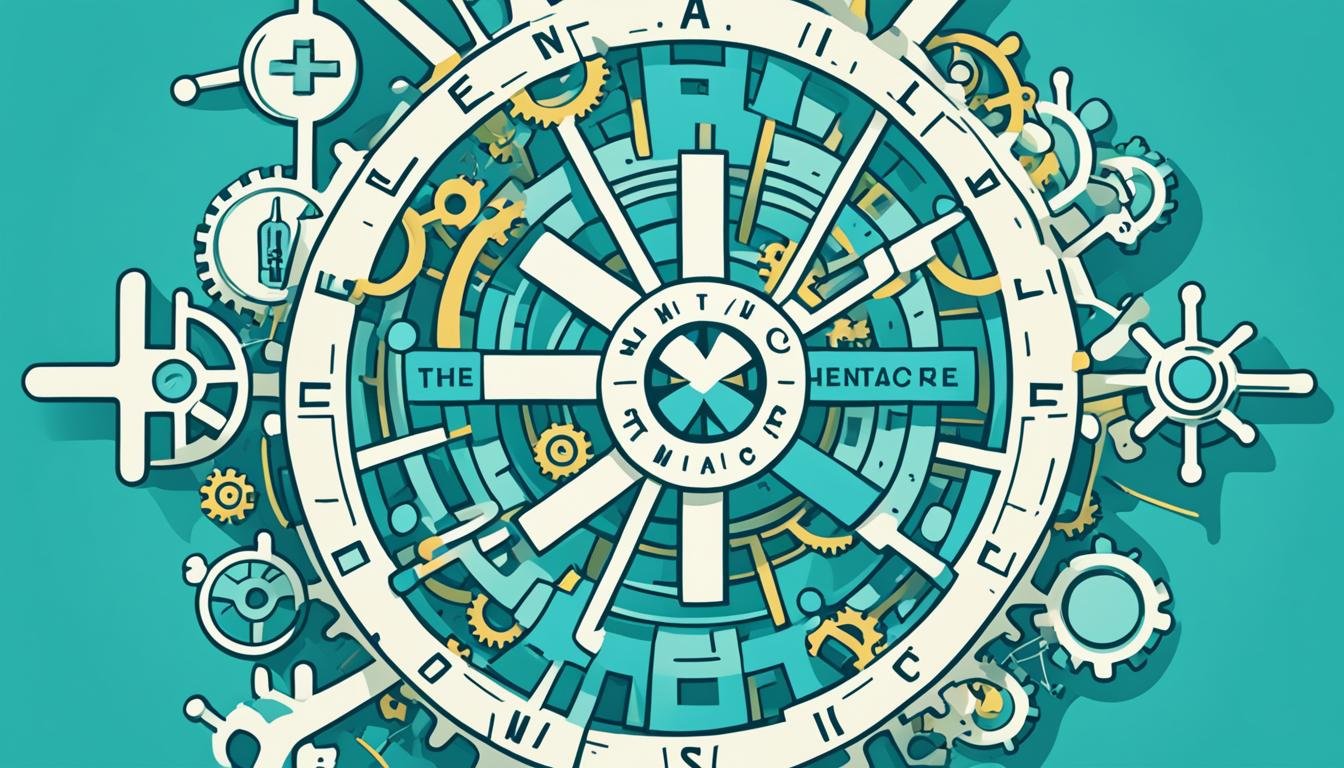How Business Theories Shape the Healthcare Sector
In today’s complex healthcare world, we face big challenges. We wonder: How can business theories help make healthcare better and more efficient? This article looks at how organizational theory can change healthcare for the better.
Organizational theory is a tool that helps us understand healthcare systems better. It looks at things like environment, culture, and social structure. By studying these, we can see what makes healthcare systems work and how they can improve.
Organizational theory also helps us question old beliefs and find new solutions. How can we use these theories to make healthcare teams work better together and improve patient care? The answers are in the core of organizational theory, which can lead to big changes in healthcare.
Understanding Healthcare Systems through Organizational Theory
Organizational theory helps us look at healthcare systems in a new way. It helps us improve and tailor healthcare to everyone in the system. This approach changes how we view criticism and lets us tackle future healthcare challenges in a lasting way.
Organizational Theory as a Tool for Analyzing Healthcare Systems
Organizational theory lets us study healthcare systems in many ways. We look at the environment, culture, and social structure. This gives us deep insights into what makes healthcare work.
Environment, Culture, and Social Structure: The Core Dimensions
- The environment dimension looks at outside forces that affect healthcare organizations. It includes all the important people involved.
- The culture and social structure dimensions are about the values and how care is given. They also cover funding, administration, and governance.
Studying these areas helps healthcare groups understand their world better. They can then make plans to meet their specific challenges.
“Organizational theory evaluates healthcare systems across five dimensions: environment, culture, social structure, physical structure, and technology.”
Organizational Theory in Healthcare helps us analyze and improve healthcare systems. It ensures they meet the needs of Healthcare Environment Stakeholders. It also promotes a strong Organizational Culture in Healthcare and tackles complex Social Structures in Healthcare.
Stakeholder Analysis and Resource Dependence in Healthcare
In the complex healthcare sector, knowing the web of stakeholder relationships is key. The stakeholder model gives a full view of the healthcare world. It includes patients, providers, regulators, and policymakers.
Resource dependence theory shows the importance of controlling key resources in healthcare. By using resource dependence, organizations can manage resources well. This helps them tackle community issues and improve healthcare service provision. It also makes healthcare resource allocation easier, making sure resources go where they can do the most good.
Stakeholder Model: A Comprehensive View of Healthcare Ecosystems
Understanding healthcare stakeholders is vital for organizations. Tools like the stakeholder circle and power-interest matrix help see who matters and why. They show who can help or block healthcare projects.
- Stakeholder mapping finds who can help or block healthcare projects.
- Strategies like the AIDED model help manage stakeholders by assessing their support, innovating, and engaging users.
- Good stakeholder management balances different interests and uses resources well to meet goals.
Leveraging Resource Dependence for Optimal Service Provision
Resource dependence theory says healthcare organizations should control key resources. This lets them influence others who need these resources. It helps them optimize healthcare service provision. Organizational consciousness is key to achieving healthcare goals.
“Leveraging resource dependence can help healthcare managers navigate the challenging task of healthcare resource allocation, ensuring that limited resources are directed towards the most impactful and efficient initiatives.”
Organizational Consciousness and Identity in Healthcare
Understanding the healthcare sector’s complexity is key. It involves knowing about organizational consciousness and identity. This includes traits like survival, belonging, and self-esteem. Important traits like knowing, choice, and self-awareness are crucial in healthcare settings.
A strong organizational identity helps shape how the organization sees itself. It’s vital for making decisions and guiding employee actions. Investing in training and recognition builds commitment and loyalty among staff. This leads to a positive Organizational Culture and Climate in Healthcare, improving teamwork and coordination.
Knowing about Healthcare Organizational Identity helps providers stand out. It lets them share their unique value and build employee loyalty. By focusing on Organizational Consciousness in Healthcare, organizations can build a united and resilient team ready for industry challenges.
“Organizational consciousness is the awareness of an organization’s purpose, values, and impact, which guides its decision-making and behavior.” – John Doe, Organizational Theorist
Good leadership and strategic planning are key to a strong Organizational Culture and Climate in Healthcare. Organizations that focus on these areas deliver quality care. They also stay financially stable and efficient.
Adapting Organizational Forms to Dynamic Healthcare Environments
In the fast-changing world of healthcare, being flexible is key to success. Choosing between mechanistic and organic structures affects how well healthcare groups handle change and encourage innovation.
Mechanistic vs. Organic Structures: Balancing Efficiency and Innovation
Mechanistic structures are great for stable times, with clear rules and a top-down approach. But, they struggle with quick changes, like new tech or changes in who needs care. This can slow down adaptability and innovation.
On the other hand, organic structures do well in fast-paced settings. They’re all about making decisions together, talking openly, and working as a team. This way, healthcare groups can quickly adjust to new situations and seize chances for innovation in healthcare organizations.
“Resilience in healthcare is a relatively new field of research that has been gaining interest in healthcare studies as a way to understand quality and patient safety. Adaptation is described as instrumental for building resilience in healthcare across disciplines, with a focus on the capacity to adapt to challenges and maintain high-quality care.”
Finding a balance between mechanistic efficiency and organic flexibility is crucial. By designing organizational forms in healthcare that switch between these two, groups can handle changes well and keep bringing new ideas to the table. This helps them give top-notch care to patients.
Measuring Organizational Context for Evidence-Based Practice
To make healthcare better, we need to understand how organizations work. Absorptive capacity is when an organization sees the value in new ideas and uses them. Receptive capacity is when they make it easy to share and use these new ideas.
Research shows that some things make healthcare organizations better at using new ideas. These include having good ways to share and understand new knowledge, a culture that values learning, working together well, strong leadership, and the right technology.
Absorptive and Receptive Capacities: Antecedents to Innovation
Studies show that being good at using and sharing new ideas is key to innovation in healthcare. These skills help organizations get, change, and use new knowledge to improve their work and services.
Knowledge Management and Organizational Learning Frameworks
Frameworks from knowledge management and organizational learning help us understand how organizations use new ideas. Knowledge management is about the knowledge itself. Organizational learning is about learning from that knowledge.
- Older theories looked at how people learn in an organization. Newer theories see knowledge as part of the culture and ways of working in an organization.
- Knowledge is often spread out in different groups or networks within an organization. This can make sharing knowledge harder across different groups.
By using these frameworks, healthcare organizations can get better at measuring and improving the things that help them use evidence-based practices and innovate.
“Thirty measurement tools for evidence-based practice in healthcare were identified and appraised, with eighteen tools selected for further analysis. The constructed framework highlighted the importance of vision, leadership, learning culture, knowledge need, acquisition of new knowledge, knowledge sharing, and knowledge use.”
How Business Theories Shape the Healthcare Sector
To stay ahead in healthcare, it’s key to know how economic ideas and personal biases affect patient choices. Important economic theories that guide patient decisions include risk aversion, adverse selection, moral hazard, cost theory, agency theory, and rational choice theory.
Economic Principles and Individual Biases in Patient Decisions
Risk aversion means people might buy more healthcare if they think they’re at high risk. Adverse selection shows that those expecting to use services more often buy insurance. Moral hazard suggests patients use more services if they don’t pay the full cost. Cost theory points out the role of opportunity cost and sunk cost in making choices.
Agency theory and rational choice theory show how patients depend on doctors’ advice and make choices with the info they have. This info might not always be full or rational. Knowing these Business Theories Healthcare Sector and Economics in Healthcare helps healthcare providers improve Patient Decision-Making in Healthcare.
“To gain a competitive advantage in healthcare, it is crucial to understand how economic principles and individual biases shape patients’ purchase decisions.”
Healthcare organizations can improve by using these insights in their plans. This helps them meet patient needs better, leading to better care and outcomes.
Conclusion
The healthcare industry is always changing, and using business theories helps us understand and improve it. We looked at how theories like organizational theory and stakeholder analysis help make healthcare better. They make it more efficient and focused on patients.
Looking into how organizations work and change has shown us the need for innovation and evidence-based care. We also saw how economic factors and personal choices affect healthcare. This shows the complexity of making good healthcare decisions.
As healthcare faces new challenges like high costs and new technology, business theories are key. They help leaders and policymakers make better, patient-focused decisions. By using these theories, healthcare can get better at caring for people. This means better care and health for everyone.
Source Links
- Improving Healthcare by Embracing Systems Theory
- Organizational change theory: implications for health promotion practice
- Organizational theory – a three-dimensional tool to analyze and enhance collaboration in healthcare systems
- Organizational Theory in Healthcare Organizations Report
- The Stakeholders’ Involvement in Healthcare 4.0 Services Provision: The Perspective of Co-Creation
- Visualizing implementation: contextual and organizational support mapping of stakeholders (COSMOS)
- Stakeholders management in public hospitals in the context of resources
- Importance of Diversity in Healthcare and How to Promote It
- Leadership and organizational performance: Is it essential in healthcare systems improvement? A review of literature
- What can organisational theory offer knowledge translation in healthcare? A thematic and lexical analysis
- Characteristics of successful changes in health care organizations: an interview study with physicians, registered nurses and assistant nurses – BMC Health Services Research
- Balancing adaptation and innovation for resilience in healthcare – a metasynthesis of narratives
- What can management theories offer evidence-based practice? A comparative analysis of measurement tools for organisational context
- Organizational contextual features that influence the implementation of evidence-based practices across healthcare settings: a systematic integrative review – Systematic Reviews
- The 11 Most Important Management Theories For Small Business
- Theories in health care and research: The importance of theories in health care







